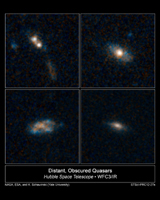
Poster Version
Click on the image for larger viewThe galaxies pictured here have so much dust surrounding them that the brilliant light from their quasars cannot be seen in these images NASA's Hubble Space Telescope.
Quasars are the brilliant beacons of light that are powered by black holes feasting on captured material, and in the process, heating some of the matter to millions of degrees.
The galaxies are part of a census of 30 quasar host galaxies conducted with two of NASA's premier observatories, the Hubble Space Telescope and Spitzer Space Telescope. They were found in the Cosmic Assembly Near-infrared Deep Extragalactic Legacy Survey (CANDELS). The study shows that 26 of the host galaxies bear no telltale signs of collisions with neighbors, such as distorted shapes.
The quasars found in normal-looking galaxies are fainter than those powered by collisions between galaxies, which send lots of gas and dust into the gravitational whirlpool of hungry black holes. The dimmer quasars are triggered by black holes snacking on such tasty treats as a batch of gas or the occasional small satellite galaxy. They are the most abundant type of quasar, according to the Hubble analysis.
The images at top right, bottom left, and bottom right reveal three of the survey's normal-looking galaxies that host quasars. Only one galaxy in the sample, at top left, shows evidence of an interaction with another galaxy. The two white blobs are the cores from both galaxies. A streamer of material, colored brown and blue, also lies below the merging galaxies.
The galaxies existed roughly 8 billion to 12 billion years ago, during a peak epoch of black-hole growth. The galaxies' masses are comparable to our Milky Way's. The blue patches are star-forming regions. The brown areas are either dust or old stars.
The images were taken by Hubble's Wide Field Camera 3 between 2011 and 2012.

